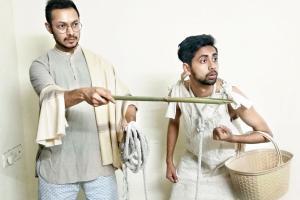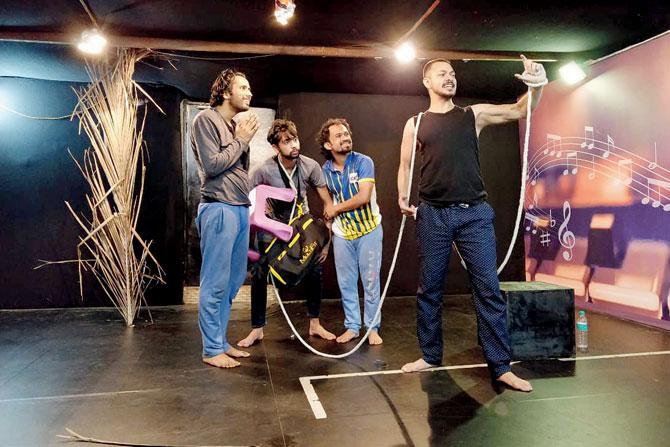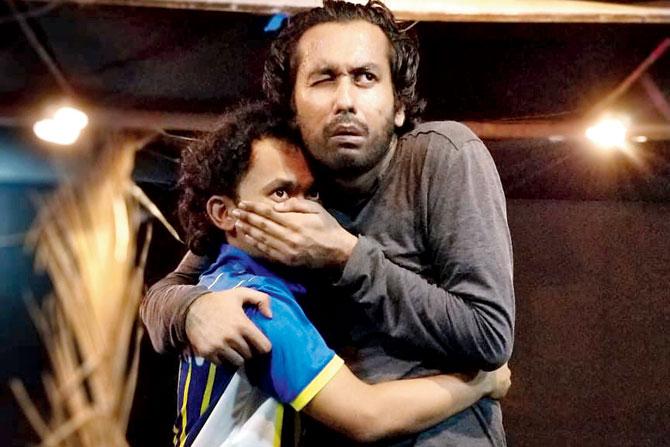Set in a classic Beckettian structure, a new play explores the literary parallels between Waiting for Godot and Kishkindha Kaand from the Ramayana

Kartavya Anthwal Sharma and Karanjot Saini portray the adapted characters of Pozzo and Lucky
Classics come with a formidable reputation. You ought to know them, have read or watched them, and inevitably, liked them. But it is only when you engage with them that you realise they don't often reveal themselves at once. They linger on in the subconscious, long after you have read them, unravelling one layer at a time, in the most unexpected context.
ADVERTISEMENT
That's the genesis of Raam Ji Aayenge, a production adapted and directed by Abhinav Grover, which explores the intertextuality of Samuel Beckett's Waiting for Godot and the Kishkindha Kaand in the Ramayana, and premieres this weekend.

Abhinav Grover, Saini, Kaustav Sinha and Sharma in rehearsal
Speaking of this unusual relook at the classic through the mythological lens, Grover tells us that he first read the play in a class on the Theatre of the Absurd as a drama school student. "But I found it very boring," he recalls, pointing to the plot where two people wait endlessly for a man called Godot, and everything that transpires in that time until they realise Godot may never show up.
That was 2015. In the next two years, Grover went to Udupi to train under Guru Sanjeev Suvarna in Yakshagana, a traditional theatre form popular in Karnataka that combines dance, music, dialogue, costume and make-up to stage stories drawn largely from the epics. "I was part of this play called Lankini Moksha, where I portrayed Ravana in a cameo role. While I didn't understand the language, I realised the audience particularly liked the part where two monkeys from the vaanar sena, while waiting from Hanuman to return from his recce to Lanka, engage in a banter," he shares. When he enquired about it later, he realised the duo was talking about having to leave their wives and families behind to fight a fight that wasn't necessarily theirs.

"Of late, we have begun to cast our mythology in a definitive mould. But the beauty of Indian folk art forms is that though they dip into ancient legends, they contemporarise the plot for the audience with relevant political and social references. That's what had worked here," shares Grover. Months later, he happened to find a Hindi translation of Waiting for Godot, and this time, it began to grow on him. That's when he also began to see parallels between the episodes of wait in Beckett's work and in the Yakshagana treatment of the Kishkindha Kaand.
It all began to come together in his theatre residency at Studio Tamaasha in June 2018, where he wrote the first act. "I was sure that the structure and turn of events was going to be Beckettian, and he has done such a fantastic job with the writing, that it made the adaptation much easier," says Grover.
To finalise the second act, the team of actors including Kaustav Sinha, Kartavya Anthwal Sharma, Karanjot Saini, Robbin Singh and Grover travelled to Udupi's Yakshagana Kendra in December, where it all started. "There is a part that has a reference to the overthrowing of Bali, and how the monkeys react to their new leader," he says. "There are always a lot of expectations from a new leader. Of course, the politics and the satire all remain in the undercurrent."
Much like what Beckett did when he put his pen to paper in 1948 during the last leg of the Second World War - an event, which on the surface, found no mention in his play, but the absurdity of which made the wait for Godot an unforgettable one.
ON: February 1, 7.30 pm and February 3, 4.30 pm and 7.30 pm
AT: Studio Tamaasha, Versova, Andheri West.
LOG ON TO: bookmyshow.com
ENTRY: Rs 250
Catch up on all the latest Mumbai news, crime news, current affairs, and also a complete guide on Mumbai from food to things to do and events across the city here. Also download the new mid-day Android and iOS apps to get latest updates
 Subscribe today by clicking the link and stay updated with the latest news!" Click here!
Subscribe today by clicking the link and stay updated with the latest news!" Click here!






